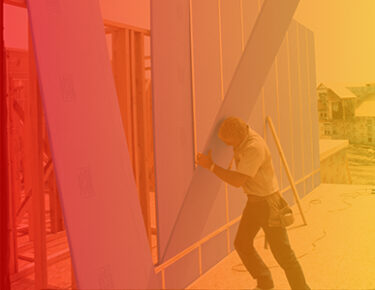 Fire Resistance
Fire Resistance
How to construct curved surfaces with gypsum board
Use the flexibility of gypsum board to bring form and function to your next project

From hotel lobbies to hospital corridors, curved surfaces can be aesthetically pleasing and functional. Creating a curved surface with rigid building materials such as gypsum board, however, can be challenging and demands careful design consideration.
In most construction projects, gypsum panels are installed to create straight lines and flat surfaces, such as walls and ceilings. When a building design incorporates curved shapes — such as round column enclosures, barrel vaults or curved walls — the additional installation complexities require planning, special installation techniques and the right flexible gypsum board.
What gypsum board products work best for curved walls?
Even though gypsum board is a rigid material, it does offer some flexibility. The board’s ability to bend, however, depends on its thickness. As the gypsum board gets thinner, its minimum bending radius decreases.
Minimum bending radius of standard gypsum board products:
- 5/8" gypsum board: 15 feet
- 1/2" gypsum board: 10 feet
- 3/8" gypsum board: 7 feet
- 1/4" gypsum board: 5 feet
Specialty gypsum board products for tighter radii
For applications requiring radii less than 5 feet, National Gypsum Company provides two product solutions manufactured by its affiliate company, Gold Bond Building Products.
Gold Bond® High Flex® Gypsum Board is specifically designed for both concave and convex surfaces and can achieve a radius as little as 7". Other benefits include:
- Lightweight, cost-efficient material that readily accepts a wide range of decorative finishes
- Board that is easily cut for quick installation, permitting painting or other decoration and the installation of metal or wood trim almost immediately
- Fire-resistant gypsum core

Lengthwise denotes long edges perpendicular to the framing members. Widthwise denotes long edges parallel to the framing members. The values listed above were achieved at 65˚F and 45% relative humidity. Lower temperatures and lower humidity will decrease the flexibility. Wetting the boards is only required on extremely tight radii, or when temperature and humidity conditions are lower than 65˚F and 45% relative humidity. When wetting the boards, apply 10-15 ounces of clean water per side with a paint roller or sprayer. Allow to soak for 10-15 minutes before bending.
Resource Alert: Review the High Flex Gypsum Board technical specification sheet for additional installation recommendations.

In certain applications, the use of a curved wall surface provides a functional purpose. For example, hospital corridors often have curved corners to accommodate the turning radius of gurneys. And because the walls form a corridor, they must also be fire rated. Used in the construction of multilayered, fire-rated curved wall assemblies, Gold Bond® XP® Fire-Shield® Radius Gypsum Board is engineered for applications requiring 1- and 2-hour fire ratings.
5/16” XP Fire-Shield Radius Gypsum Board is specifically engineered for curved walls and partitions requiring a fire rating. Other benefits include:
- Can achieve a minimum radius of 2 feet
- Scores and snaps easily, with no special handling requirements
- Consists of a high-density, fire-resistant gypsum core encased in a heavy abrasion-, mold-, mildew- and moisture-resistant PURPLE paper
Resource Alert: Explore UL Design V438 for 1-hour and 2-hour fire-rated curved corner designs on pages 48 and 49 of The PURPLE Book®.
Installation Recommendations for Curved Gypsum Board Applications
- To prevent flat spots: Framing members should be spaced closer together than required for typical flat wall and ceiling surfaces.
- For concave surfaces: A stop should be applied to one end of the curve to restrain one end or edge of the board during installation. Apply pressure to the unrestrained end or edge of the gypsum board, forcing the field of the gypsum board into firm contact with the framing. Fasten gypsum board by working from the “stopped” end or edge. The gypsum board should be held tightly against the framing while fasteners are being driven.
- For convex surfaces: One end of the gypsum board should be attached to the framing with nails or screws. Progressively push the gypsum board into contact with the framing members, working from the fixed end to the free end. The gypsum board should be held tightly against each framing member while fasteners are being driven.

Resource Alert: Check out GA-226 Application of Gypsum Board to Form Curved Surfaces from the Gypsum Association.
How to Construct Curved Walls in Wet Areas
Gypsum board is not a suitable building material for areas of high humidity, such as swimming pool enclosures and showers. For wet areas that also include a curved surface or feature, National Gypsum, provides 1/2" PermaBASE® Cement Board, which is manufactured by PermaBASE Building Products and can be bent to a 5-foot radius. Other benefits include:
- Designed to withstand prolonged exposure to moisture
- Stays intact when exposed to water; will not rot, disintegrate or swell
- Achieves the industry’s lowest water-absorption rating (ASTM C473)
- Helps inhibit mold growth with the highest possible score on mold tests (ASTM D3273 and ASTM G21)
Need additional support? Contact the technical experts on National Gypsum’s Construction Services team at 1-800-NATIONAL®.
Related Blog Posts

PURPLE: The color that changed everything
Setting the standard for moisture, mold and mildew resistance in ...
Read MoreRelated Podcasts

Episode 4: Understanding the ratings behind acoustical wall, ceiling and roof assemblies
Familiarize yourself with STC, IIC, CAC and OITC rating classes a...
Listen Now









